meta: One of These Things Is Not Like the Other: Dinosaurs On a Spaceship
Some meta on Dinosaurs on a Spaceship. Looking at the use of mirroring, juxtaposition of opposing ideas, a conflicted Doctor, eye symbolism, vid screens as looking glasses, the theme of fertility and the Doctor's relationship with the Ponds.
Conflict and Mirroring
One of the things the Moffat era does often is juxtapose opposites, or place ideas together that are naturally in conflict with each other, in order to mirror them.

janie_aire has written wonderfully on the use of the "X" motif in Moffat era Who and how it is used as a motif to represent this idea (along with the idea of squaring the circle, which she also talks about,) her examination of the X motif in Asylum can be found here. It's also worth mentioning that the X symbol is also one of the runes of the Elder Futhark (the writing and magical language system of the ancient Scandinavian and teutonic countries.) As a rune its name is Gebo ,and it's surface meaning is "gift" but its layered meaning is: exchange, crossover, union of two separate forces.
There's been that twinning of the colours red and blue, often representing fire and water all the way through series 5 and 6, and in Pond Life at the beginning (with the fire falls.) I've been interested to see how the titles have actually changed to reflect this; the vortex is now blue/green, leading to the usual tunnel of fire just before the main logo pops up - and also the graphics that display the actor's names have a sort of water shimmer effect on them.
No less here with the ideas that don't go together... going together. Dinosaurs, a thing long gone, on a spaceship, a thing of the future (in sci-fi terms). An ocean, on a spaceship. The lethal robots that can kill and injure, but have petulant ridiculous voices, a kiss and then a slapping for Rory from the Doctor.
One interesting scene where we see both the X motif and a Doctor who is in conflict with the two sides of himself, is the first scene with Solomon. Our first sign that something is afoot on this score is when the gateway shuts between Rory/Brian and the Doctor, with bars that cross over into Xs. On one side we have the Doctor who is in conflict with himself, inside a room with red squares on the wall, shot to show them as Xs. His warrior and healer sides jar and clash as he tries to extract information from Solomon, threatening to withhold treatment if Solomon doesn't tell him what's going on.
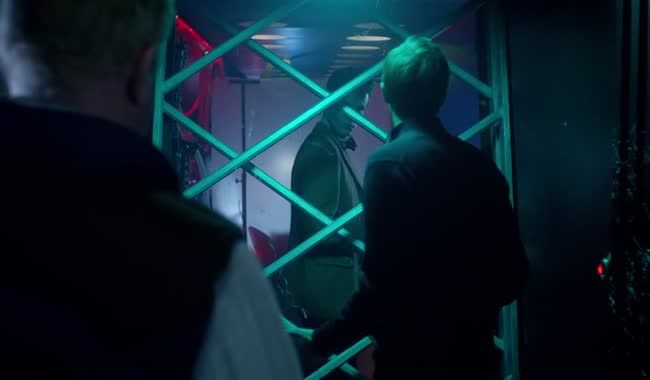
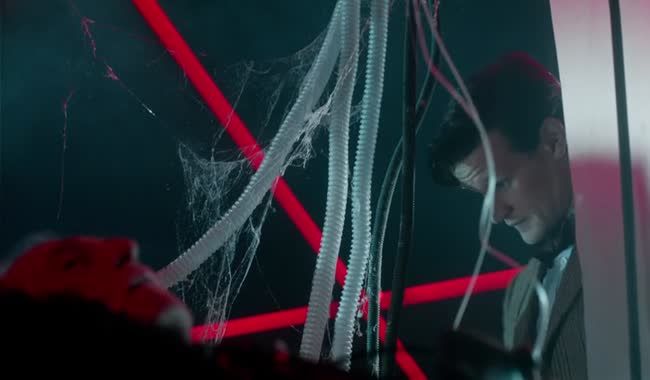
On the other side of the bars we have Rory. Rory is both a warrior and a healer, in the form of nurse and roman centurion. He manifests both sides of himself here also, healing his dad with the med pack he keeps on him, and threatening to reconstruct and melt down the annoying robots.
When a call is received from Amy, we see the phone passed back and forth between the X motif gateway. This is evocative of how Amy passes between both of her two worlds; life at home with warrior/healer Rory, and life on the road with warrior/healer Doctor. It's not lost on me that Amy is mirrored to Nefertiti (are you a queen as well?) and that Nefertiti names herself with one of her titles "Lady of the Two Lands". Amy could also be called by the same title; she straddles both the ordinary world and the world of the Tardis in time and space, and the pull of both of those on her is becoming a key theme of this series.
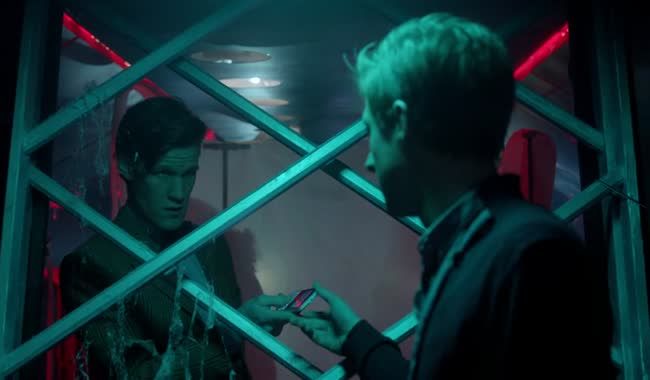
Though, to be honest, our lovely Ponds themselves are back in sync again - visually they are in sync, actually wearing the same design of top. Emotionally they are also now back in sync, seeming relatively happy and both of them at a stage in their lives now where they are hankering for home.
Anyway, when the Doctor finally gets off the phone he accuses Solomon thus:
Doctor: Piracy and genocide
Solomon: Very emotive words Doctor.
Doctor: Oh, I'm a very emotive man.
It's hypocritical, and again shows him in conflict with himself. What he accuses Solomon of, he himself is responsible for. He stole a ship and ran away, he committed genocide.
Our final hint of this conflict going on within him - and the most worrying, to me, is the fact that he leaves Solomon behind to be blown up by the missiles. Not just that, but he really rubs the man's fate in to him before he leaves. I don't blame him, but there's a side of the Doctor that abhors actions such as this, there's a side of him that believes nobody is beyond redemption. This is the man who grieves over a dying stegosaurus. But it seems as if the warrior side of him is hell bent on vengeance in this episode. And it's this juxtaposition of his gentle, childlike, healer side with this frightening warrior force of nature we're seeing that is the most chilling for me.
Nefertiti and Eye symbolism
There's some interesting stuff around Queen Nefertiti which mirrors the Doctor. Of course, Egyptian symbolism has been used by Moffat before particularly in series 5 with River (River as Cleopatra, wearing a headdress.) Nefertiti's appearance here, and in much of popular media is based upon the famous bust of her which was recovered from Egypt. (I want to say t'Egypt here, but I fear my American and Australianfriends may not follow the joke.)
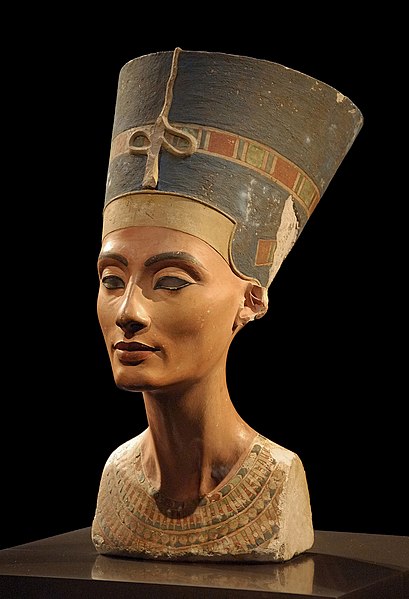
First fascinating thing to note is: considering the occasions in the last and this series that we see the Doctor with one eye obscured and the recurrence of eyes and perception as a theme, the bust of Nefertiti has its left eye missing. In series 5, we see the Doctor's left eye, and the eye of other characters, obscured by the eyepatch, In Asylum of the Daleks he is shown on several occasions with his right eye closed or obscured. Also interesting is that this bust has been CT scanned and it has been shown that underneath the layer of perfection that we appear to see, the sculptor initially tried to depict signs of aging and later added layers to smooth out his sculpture. The inner sculpture has bags under her eyes, wrinkles on her neck, creases around her mouth and cheeks and a bump on her nose. So with this depiction of her we have age obscured under a young face...sound familiar?
And the eye type circle within a circle symbol is still around, though not quite a prolifically as in Asylum; here's a few examples; on the door which opens to reveal the dinosaur, on a box on the floor and on the screens of the ship's navigation controls. These are all also examples of the circle within a square symbol - another image that comes up a lot in Moffat era Who and that's evocative of union of opposites, doing the impossible, combining two opposite worlds.
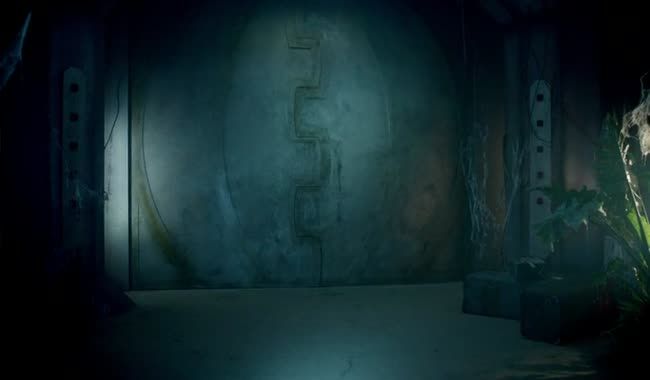
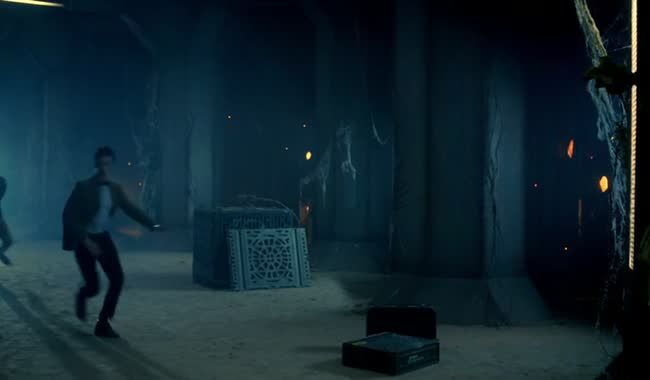
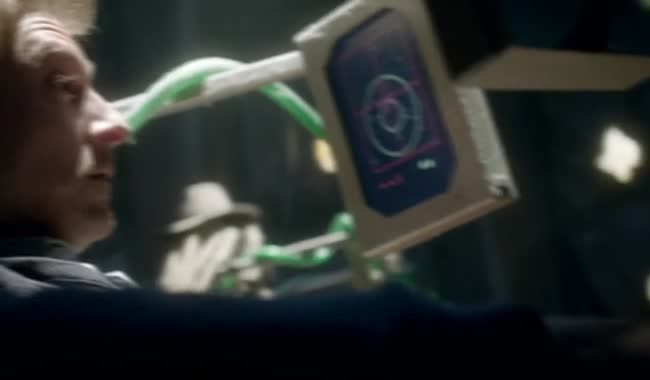
Through the Looking Glass
One of the things that has carried through from Asylum, and which I wonder whether will be a theme in the series, is the use of characters looking straight into screens. It feels like a 4th wall breach, as characters are looking directly at us, pointing at us, commenting on us. The roles are reversed though, because visually, here we are the ones looking out of screens at them, even as we watch them looking at us. It's not so much reversal as mirroring (which is of course a key theme in Moffat era Who.)

Amy: How about a picture, hmm? Come on, for me.
Nefertiti: (pointing at screen) It's beautiful.
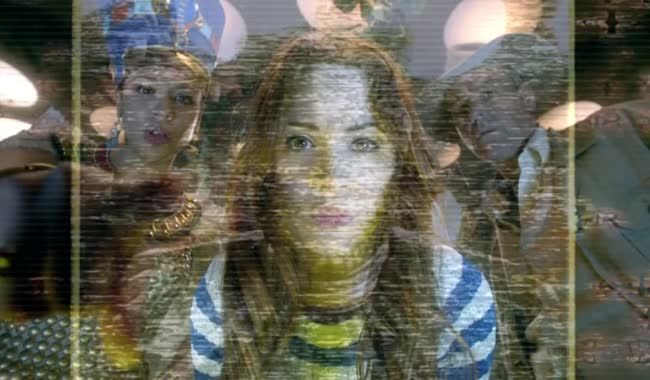
It's used to great effect in a couple of places as well, to link in with other ideas.
First, remember in Asylum where we had the Dalek-Human beings, with the blue light of a Dalek eyestalk in their head? Well, the light in the centre of the head can be read as a symbol of the third eye, albeit in that case one which the Daleks had symbolically perverted for their own reasons. Here we have the Indian Space Agency, some of whose staff are wearing Bindis a decoration worn in the middle of the forehead to symbolise the third eye. When the Doctor discusses them launching their missiles at the ship, Indira's own actual ayes are superimposed on to the Doctor's and Rory's foreheads as they move around in front of the screen. It's an interesting continuation of all the eye symbolism in Asylum (and the last 2 series.) I'll make these pictures bigger as you have to squint a little.

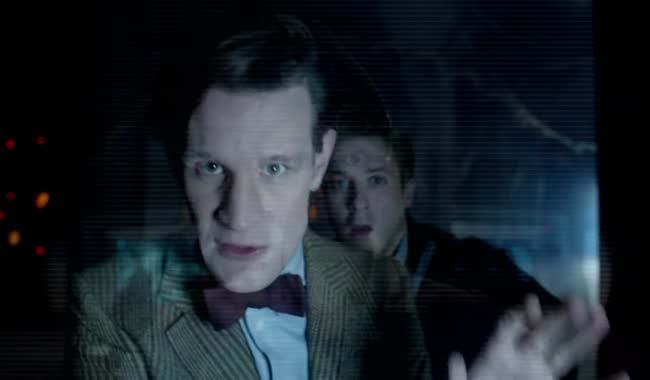
Eggs/Fertility
There's still much going on about Amy's fertility in this ep on the meta level. The screen POV technique is used here to illustrate that in the sequence here where Amy accesses the ship's data records. We get the data records themselves held in a spherical casing, very reminiscent of Rory and his eggs last episode.

Next we get this sequence:
Amy: Computer, show me the ship at launch, with all life signals(first image appears.) Now show me the ship today with all life signals (second image appears.)
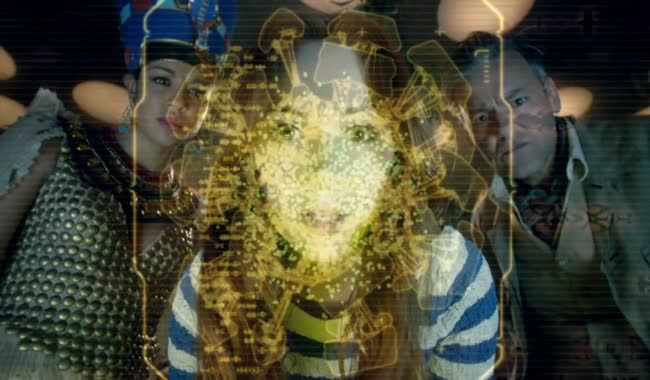
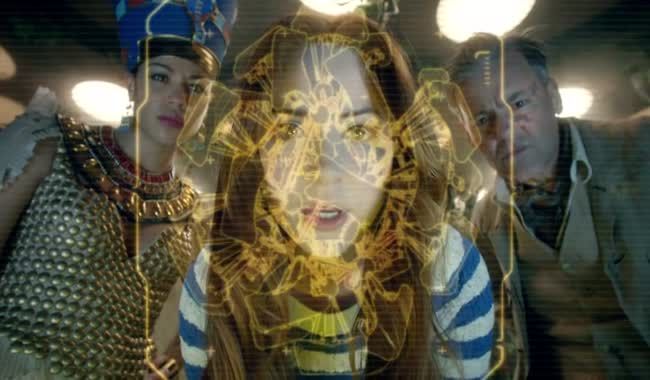
Amy: Show me both images, then and now, side by side...Okay, two images, spot the difference, what changed?

I'd suggest that this sequence reflects back to us what has changed for Amy as well as on board the ship.
Then: Amy's eggs were viable, as we know she bore a child. The image itself is evocative of an ovary filled with many many eggs, signs of potential life - and indeed he whole Ark concept is about saving life in order to populate or repopulate areas - it's very much about keeping the chain of life going through reproduction. Now: No signs of life. Amy can't have children.
The interesting thing also is that Amy is acting as the Doctor in this scene: she speaks about the things she has learned from him, she refers to Nefertiti and Riddell as her companions and makes a very Doctor-ish objection to them flirting. She's become a mirror of the Doctor, and she has gained certain things from that but the emphasis here is on the high price she has paid.
We also have the broken eggs;
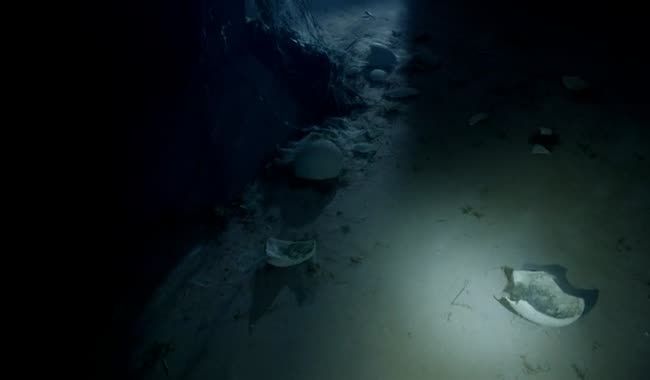
A parent/child relationship and interactions with Rory and his father, and references to his dad's balls.

The Doctor as Parent
The parent/child theme links very much into the idea of the relationship that the Doctor has with the Ponds. Bear with me here. I mentioned far above how our Ponds are now back in sync with each other in terms of wanting to be at home more. One of the things about the Peter Pan aspect of the Doctor, is that people grow when they are with him: they are younger at the start and once they have reached a symbolic adulthood and no longer need his magical presence in their lives, they leave. He's done something here that he doesn't normally do with people: he's gone back. He's not just gone back once, either; he's gone back over and over to the Ponds. It's a progressive step for him in terms of his ability to maintain and develop relationships over a long term basis, but my feeling is that it hasn't necessarily been good for the Ponds. In some ways he's kept them in a suspended childhood: they haven't seriously been able to set up home or have anything like a normal life together until the end of series 6. However, even though they do have that now, we've seen in Pond Life the effect of the constant interruptions of chaos on their lives.
Amy called out to him to help with her relationship; We need you raggedy man. I need you.
The Doctor was the one responsible for them reconciling.
There's a sequence in this ep which is reflective of this impact the Doctor has on Amy's life. In the control room at the ten, with Rory and his dad seated in the navigation chairs, the Doctor begins pulling stuff out of a hole as he has a conversation with Amy:

First off, this act of pulling stuff out of a hole keys us into the fact that the Doctor is gong to draw out some issues, things that are bubbling under the surface of his relationship with the Ponds. The dialogue is brill and it explains pretty much everything that's going on for them.
Doctor: Shine a torch down here.
Amy: What are you doing?
Doctor: Mixing my messages. How's the job?
First off, Amy's shining a torch into more than just that hole, she's shining a torch into the whole crux of the relationship between her and the Doctor. Also, what's this about mixed messages? Is the Doctor aware of the mixed messages he's been sending to the Ponds by leaving long gaps between his visits, but still visiting? Is he unable to help himself, unable to stay away? Or trying to offer them the best of both worlds: being in their lives, but not in it too often.
Amy: We're about to be hit by missiles and you're asking me that?
Doctor: I work best when I'm multi-tasking. Keep talking. How's the job?
Amy: I gave it up
Doctor: You gave the last one up!
Amy: Yeah, well, I can't settle. Every minute i'm listening out for that stupid Tardis sound.
The Doctor is digging for info here, and he does sound parental. Holding down a steady job is seen in our society of so much of a marker of adulthood; of the ability to be responsible, settled. That waiting for the Tardis is what means Amy can't settle.
Doctor: Right, well, it's my fault is it?
Amy: I can't not wait for you, even now. And they're getting longer now, the gaps between your visits. I think you're weaning us off you.
Doctor: I'm not, I promise. I really promise. The others, they're not you. But you and Rory, you have...lives, each other. I though that's what we agreed.
The language is interesting. The idea of weaning off - reminiscent of them being fathered by him, being kept as young, unable to grow. It's also a hint of what Amy has lost, both in Melody and the ability to have children. Yet the Doctor's reaction makes me wonder if exactly the opposite is happening. Is he weaning himself off them, knowing that one day they will die and he will have to move on, knowing on some level that he is not good for them?
Amy: I know....I..I just worry there'll come a time when you never turn up, that something will have happened to you and I'll still be waiting and never knowing.
Doctor: No. Come on Pond, you'll be there til the end of me.
Amy: Or vice-versa.
This last bit makes me wonder even more if he is weaning himself off the Ponds. It's his deepest fear, I think - that he will see the end of them. He wants and needs to part company with them before that happens. But they're Ponds, not people...so how can he?

Thanks for reading